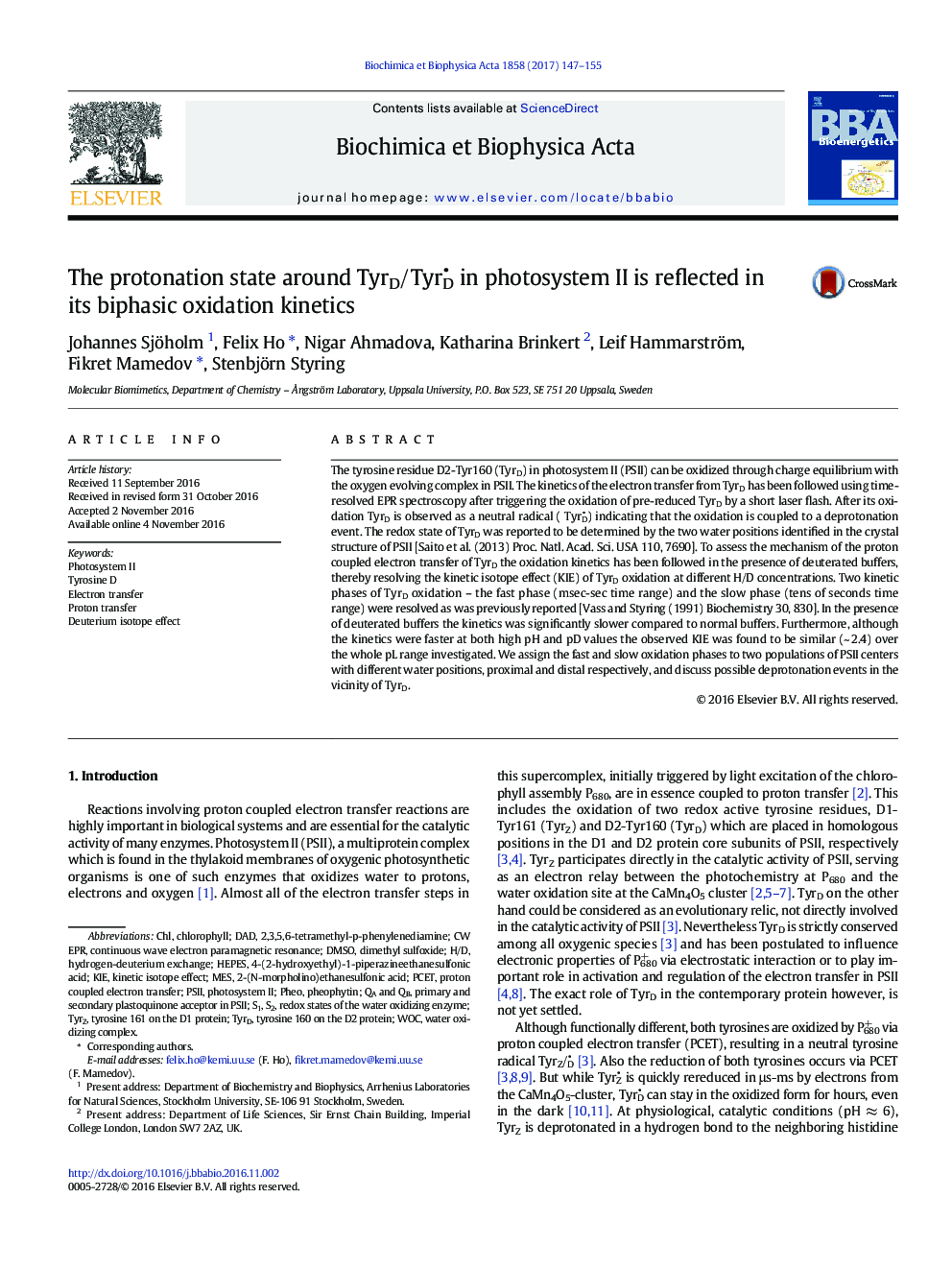| Article ID | Journal | Published Year | Pages | File Type |
|---|---|---|---|---|
| 5507183 | Biochimica et Biophysica Acta (BBA) - Bioenergetics | 2017 | 9 Pages |
Abstract
The tyrosine residue D2-Tyr160 (TyrD) in photosystem II (PSII) can be oxidized through charge equilibrium with the oxygen evolving complex in PSII. The kinetics of the electron transfer from TyrD has been followed using time-resolved EPR spectroscopy after triggering the oxidation of pre-reduced TyrD by a short laser flash. After its oxidation TyrD is observed as a neutral radical (TyrD
- ) indicating that the oxidation is coupled to a deprotonation event. The redox state of TyrD was reported to be determined by the two water positions identified in the crystal structure of PSII [Saito et al. (2013) Proc. Natl. Acad. Sci. USA 110, 7690]. To assess the mechanism of the proton coupled electron transfer of TyrD the oxidation kinetics has been followed in the presence of deuterated buffers, thereby resolving the kinetic isotope effect (KIE) of TyrD oxidation at different H/D concentrations. Two kinetic phases of TyrD oxidation - the fast phase (msec-sec time range) and the slow phase (tens of seconds time range) were resolved as was previously reported [Vass and Styring (1991) Biochemistry 30, 830]. In the presence of deuterated buffers the kinetics was significantly slower compared to normal buffers. Furthermore, although the kinetics were faster at both high pH and pD values the observed KIE was found to be similar (~Â 2.4) over the whole pL range investigated. We assign the fast and slow oxidation phases to two populations of PSII centers with different water positions, proximal and distal respectively, and discuss possible deprotonation events in the vicinity of TyrD.
- ) indicating that the oxidation is coupled to a deprotonation event. The redox state of TyrD was reported to be determined by the two water positions identified in the crystal structure of PSII [Saito et al. (2013) Proc. Natl. Acad. Sci. USA 110, 7690]. To assess the mechanism of the proton coupled electron transfer of TyrD the oxidation kinetics has been followed in the presence of deuterated buffers, thereby resolving the kinetic isotope effect (KIE) of TyrD oxidation at different H/D concentrations. Two kinetic phases of TyrD oxidation - the fast phase (msec-sec time range) and the slow phase (tens of seconds time range) were resolved as was previously reported [Vass and Styring (1991) Biochemistry 30, 830]. In the presence of deuterated buffers the kinetics was significantly slower compared to normal buffers. Furthermore, although the kinetics were faster at both high pH and pD values the observed KIE was found to be similar (~Â 2.4) over the whole pL range investigated. We assign the fast and slow oxidation phases to two populations of PSII centers with different water positions, proximal and distal respectively, and discuss possible deprotonation events in the vicinity of TyrD.
Keywords
PSIITyrZWOCPheoTyrDDADChlPheophytinPCETTyrosine DHEPESCW EPR2-(N-morpholino)ethanesulfonic acid2,3,5,6-tetramethyl-p-phenylenediamine4-(2-hydroxyethyl)-1-piperazineethanesulfonic acidDMSOH/DQA and QBKinetic isotope effectDeuterium isotope effectelectron transferProton transferDimethyl sulfoxidecontinuous wave electron paramagnetic resonanceChlorophyllPhotosystem IIHydrogen-deuterium exchangewater oxidizing complexMeSProton coupled electron transferKIE
Related Topics
Life Sciences
Agricultural and Biological Sciences
Plant Science
Authors
Johannes Sjöholm, Felix Ho, Nigar Ahmadova, Katharina Brinkert, Leif Hammarström, Fikret Mamedov, Stenbjörn Styring,
